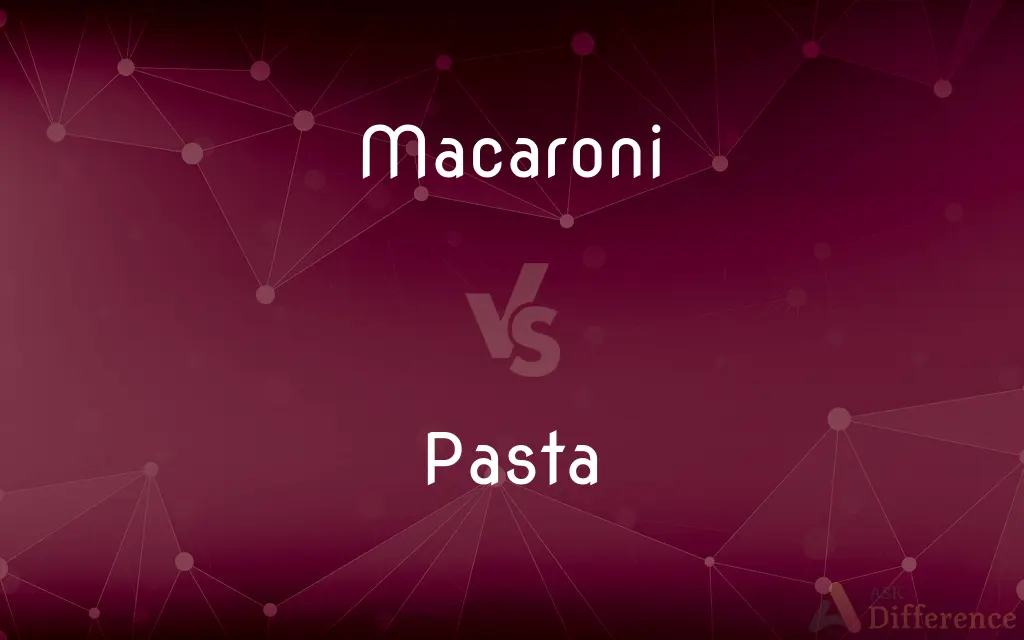Macaroni vs. Pasta — What's the Difference?
By Urooj Arif & Fiza Rafique — Updated on April 17, 2024
Macaroni is a type of pasta characterized by its narrow tube shape, while pasta is a broader category that includes various shapes like spaghetti, fusilli, and ravioli.

Difference Between Macaroni and Pasta
Table of Contents
ADVERTISEMENT
Key Differences
Macaroni refers specifically to narrow, tube-shaped pasta that is often used in dishes like macaroni and cheese. Whereas pasta encompasses a wide variety of shapes, sizes, and types including long strands, sheets, and stuffed varieties.
Macaroni is typically made from durum wheat and water, forming its distinctive tube shape that holds sauces well. On the other hand, pasta can be made from several types of flour and might include other ingredients like eggs, which affect its texture and flavor.
In many cuisines, macaroni is primarily used in baked dishes and soups. While pasta is versatile, used in a range of dishes from simple buttered noodles to complex layered lasagnas.
Macaroni is often associated with comfort food in American and British cultures. Conversely, pasta has a broad cultural significance, prominently featured in Italian cuisine and appreciated worldwide.
Comparison Chart
Shape
Narrow, tube-like
Various shapes (e.g., strands, tubes, sheets)
ADVERTISEMENT
Common Uses
Macaroni and cheese, casseroles, soups
Diverse dishes including salads, soups, main courses
Ingredients
Durum wheat, water
Durum or other wheat, possibly eggs
Cultural Significance
Popular in American and British comfort food
Staple in Italian cuisine, widely adapted globally
Texture
Generally smooth and uniform
Ranges from smooth to ridged, thin to stuffed
Compare with Definitions
Macaroni
A type of pasta with a narrow, tube-shaped form.
She prepared a delicious macaroni and cheese for dinner.
Pasta
Encompasses a range of culinary uses from salads to main courses.
She experimented with pasta shapes to add flair to her salads.
Macaroni
Typically made from durum wheat.
Macaroni holds up well in baked dishes due to its durum wheat composition.
Pasta
An Italian cuisine staple that comes in numerous shapes and sizes.
For dinner, they made pasta with a light garlic sauce.
Macaroni
Commonly found in Western cuisine.
Macaroni salad is a popular side dish at American picnics.
Pasta
Integral to many international dishes.
Pasta is versatile, used in both traditional Italian dishes and innovative global recipes.
Macaroni
Often used in comfort food dishes.
His favorite comfort meal is macaroni mixed with creamy cheddar sauce.
Pasta
Can be made with a variety of ingredients including eggs.
Fresh pasta often includes eggs, enhancing its yellow color and tender texture.
Macaroni
Associated with simple, hearty meals.
She made a quick macaroni casserole for a weeknight meal.
Pasta
Reflects a wide range of cooking techniques.
He mastered the art of pasta making, from extruding spaghetti to crafting ravioli.
Macaroni
Macaroni (, Italian: maccheroni) is dry pasta shaped like narrow tubes. Made with durum wheat, macaroni is commonly cut in short lengths; curved macaroni may be referred to as elbow macaroni.
Pasta
Pasta (US: , UK: ; Italian pronunciation: [ˈpasta]) is a type of food typically made from an unleavened dough of wheat flour mixed with water or eggs, and formed into sheets or other shapes, then cooked by boiling or baking. Rice flour, or legumes such as beans or lentils, are sometimes used in place of wheat flour to yield a different taste and texture, or as a gluten-free alternative.
Macaroni
Pasta in the shape of narrow tubes.
Pasta
A dish originally from Italy consisting of dough made from durum wheat and water, extruded or stamped into various shapes and typically cooked in boiling water.
Macaroni
An 18th-century British dandy who imitated continental fashions.
Pasta
Unleavened dough, made with wheat or other flour, water, and sometimes eggs, that is molded into any of a variety of shapes and boiled.
Macaroni
Pl. macaroni Pasta in any of various hollow shapes, especially short curved tubes.
Pasta
A prepared dish containing pasta as its main ingredient.
Macaroni
A well-traveled young Englishman of the 1700s and 1800s who affected foreign customs and manners.
Pasta
(uncountable) Dough made from wheat and water and sometimes mixed with egg and formed into various shapes; often sold in dried form and typically boiled for eating.
Macaroni
A fop.
Pasta
(uncountable) A dish or serving of pasta.
Macaroni
(uncountable) A type of pasta in the form of short tubes; sometimes loosely, pasta in general.
Pasta
(countable) A type of pasta.
Macaroni
A fop, a dandy; especially a young man in the 18th century who had travelled in Europe and who dressed and often spoke in an ostentatiously affected Continental manner.
Pasta
Any of a variety of edible unleavened doughey preparations made from flour, eggs and water, originating in Italy, and shaped into various forms, such as solid strings (as spaghetti), hollow tubes, or layered squares (ravioli). They may be mixed with various sauces, often having a tomato base, or filled with meat or cheese fillings.
Macaroni
(obsolete) A macaroon.
Pasta
Shaped and dried dough made from flour and water and sometimes egg
Macaroni
(historical) Chic, fashionable, stylish; in the manner of a macaroni.
Macaroni
Long slender tubes made of a paste chiefly of a wheat flour such as semolina, and used as an article of food; a form of Italian pasta.
Macaroni
A medley; something droll or extravagant.
Macaroni
A sort of droll or fool.
Macaroni
A finical person; a fop; - applied especially to English fops of about 1775, who affected the mannerisms and clothing of continental Europe.
Macaroni
The designation of a body of Maryland soldiers in the Revolutionary War, distinguished by a rich uniform.
Macaroni
A British dandy in the 18th century who affected Continental mannerisms;
Yankee Doodle stuck a feather in his cap and called it macaroni
Macaroni
Pasta in the form of slender tubes
Common Curiosities
Can macaroni be considered pasta?
Yes, macaroni is a subtype of pasta.
What dishes are commonly made with macaroni?
Macaroni is often used in macaroni and cheese, casseroles, and soups.
What types of flour are used to make pasta?
Pasta can be made from durum wheat flour, all-purpose flour, and sometimes includes eggs.
What is the primary difference between macaroni and pasta?
Macaroni is a specific type of pasta with a tube-like shape, while pasta includes a variety of shapes and styles.
Is pasta healthy to eat?
Pasta can be part of a balanced diet, providing carbohydrates and, depending on the ingredients, some protein and vitamins.
Are there gluten-free pasta options?
Yes, there are gluten-free pastas made from corn, rice, or other gluten-free grains.
What are some popular pasta dishes?
Popular pasta dishes include spaghetti Bolognese, lasagna, and fettuccine Alfredo.
What is the best way to cook pasta to achieve the perfect texture?
Pasta is best cooked al dente, which means it should be tender but still firm to the bite.
How is macaroni typically prepared?
Macaroni is usually boiled and can be baked in dishes like macaroni and cheese.
Can pasta be used in vegetarian recipes?
Yes, pasta is a staple in many vegetarian dishes.
Share Your Discovery

Previous Comparison
Herefore vs. Therefore
Next Comparison
Mobile vs. PhoneAuthor Spotlight
Written by
Urooj ArifUrooj is a skilled content writer at Ask Difference, known for her exceptional ability to simplify complex topics into engaging and informative content. With a passion for research and a flair for clear, concise writing, she consistently delivers articles that resonate with our diverse audience.
Co-written by
Fiza RafiqueFiza Rafique is a skilled content writer at AskDifference.com, where she meticulously refines and enhances written pieces. Drawing from her vast editorial expertise, Fiza ensures clarity, accuracy, and precision in every article. Passionate about language, she continually seeks to elevate the quality of content for readers worldwide.














































